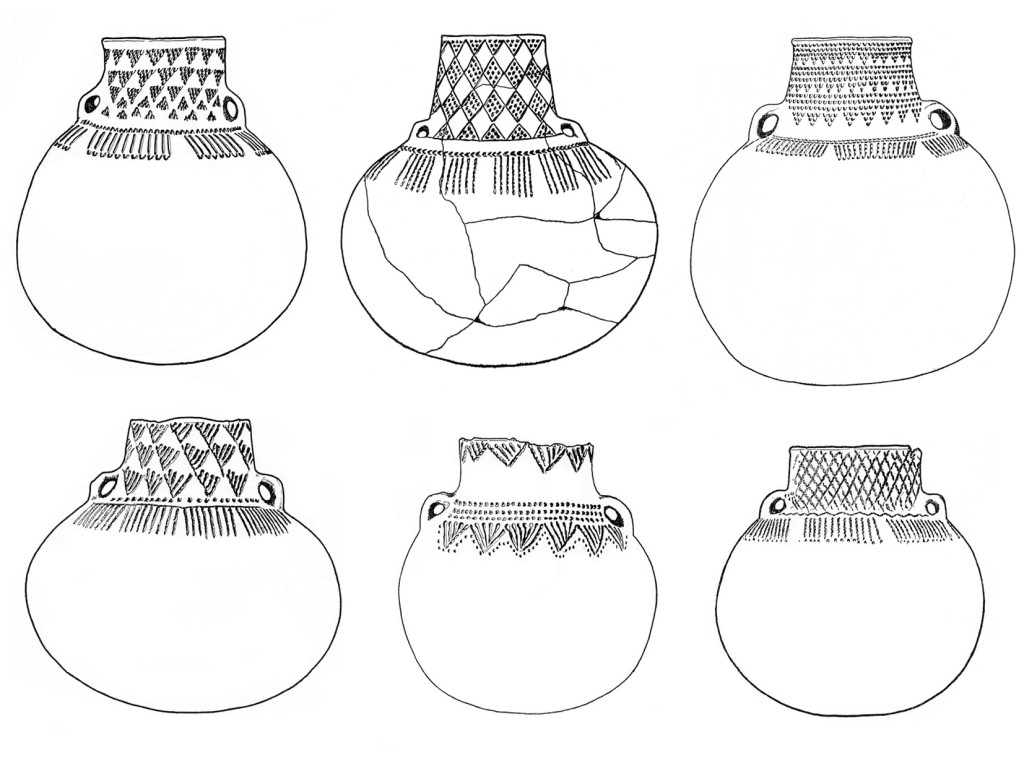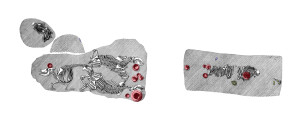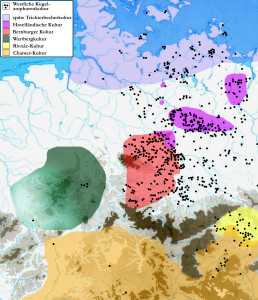Die Westliche Kugelamphorenkultur bildet an der Wende des 4. zum 3. Jahrtausend v. Chr. einen relativ heterogenen Kulturkomplex, der sich durch ein Nebeneinander regionaler und überregionaler Elemente auszeichnet. Für die erstrebte raum-zeitliche Differenzierung wurde ein innovativer methodischer Ansatz verfolgt, der multivariate Statistik mit GIS-basierten Analysen kombiniert. Somit ließen sich eine überregionale Westgruppen-Ornamentik sowie drei regionale Verzierungsstile herausfiltern. Der Ausschluss der regionalen Motive bei den chronologischen Analysen gestattete es, den allgemeinen Entwicklungstrend herauszuarbeiten.
Research
The Globular Amphore Culture

Globular Amphoras from Saxony-Anhalt with different ornamentation elements and technics (after Beier 1988)
The sites of the Globular Amphora culture (GAC) can be found across broad swaths of Central and Eastern Europe. Between 3100 and 2700 BC, its distribution area extended from the Elbe-Weser-region in the west to the Dniepr in the east. Natural expansion barriers include the Baltic Sea in the north and, roughly speaking, the German and Czech lower mountain ranges in the south, as well as the arc of the Carpathian Mountains. An internal differentiation into three subgroups has been established through previous research into this extensive archaeological complex. For the Western GAC, which covers the areas west of the Elbe River, the last comprehensive study was carried out in 1938. Since then, only regional studies have been pursued. The number of known sites has increased dramatically since then. Currently there are 900 sites in the project database, which can be used as a foundation for any further modern analyses.
Differentiation in Space and Time

The burial complex of the Globular Amphora culture at Zauschwitz in Saxony with a human double grave, a triple cattle deposit and a characteristic set of grave furniture (after Coblenz/Ftizsche 1962)
Why does the differentiation in space and time of the GAC constitute one of the main research objectives? Research into this question can provide new evidence for the expansion of the GAC over such a vast territory. After classifying all the different kind of finds, mapping via ArcGIS will reveal regional elements and types. For the chronological differentiation, the correspondence analyses will prove the proper method to investigate the changes in shape and decoration of ceramics.
Cultural and Anthropological Identity

Sites of the Western Globular Culture (after Preuss 1998) and the distribution areas of the contemporary neighbouring cultural groups at 3000 BC
Which observations can offer indications for investigations concerning the cultural and anthropological identity of this late Neolithic population? During the expansion of the GAC within the area being researched, a discernible transition from collective burials towards individual graves took place. This change in tradition offers one opportunity to obtain an insight into the awareness of identity demonstrated by the people concealed behind this archaeological complex. The expenses of grave constructions and the individual configuration of grave furniture seem to indicate a hierarchically structured society.
A further highly interesting aspect is the connection between some human burials and cattle burials or deposits. In particular, regularly observed deposits consisting of two animals in antithetic crouched position, which are widely interpreted as a harnessed bovine team, seem to be characteristic of the time period for the GAC. These findings underline the extraordinary status enjoyed by domestic animals, which is often used to argue that the agricultural practices of the GAC were mainly based on cattle breeding.
Individual interactions with contemporary neighbouring cultural groups reveal the problems caused by the use of the term “cultural group’ in connection with the GAC. Perhaps the GAC could be described as a Neolithic parallel society, which gradually integrated into the indigenous cultural environment through sharing of settlements and burial sites with local cultural groups. At the same time, the GAC clearly isolated itself and developed its own separate settlement clusters.
The Working Hypothesis
What were the reasons for the GAC’s integration with other local groups and its widespread expansion? One possibility could be the desire to access local raw materials, such as salt, amber, copper or flint. Or perhaps it was the complementary system of agriculture? The agricultural system in question permitted the opening up of previously unpopulated areas with less fertile soils. With the climatic decline, it offered the local cultural groups the acceptable alternative of subsistence agriculture, which then caused the further expansion of the GAC in those regions.
The dissertation was successfully completed in 2012. It has been published in 2014 within the series Topoi. Berlin Studies of the Ancient World (Vol. 24) with the title: “Die westliche Kugelamphorenkultur. Untersuchungen zu ihrer raumzeitlichen Differenzierung, kulturellen und anthropologischen Identität”.
